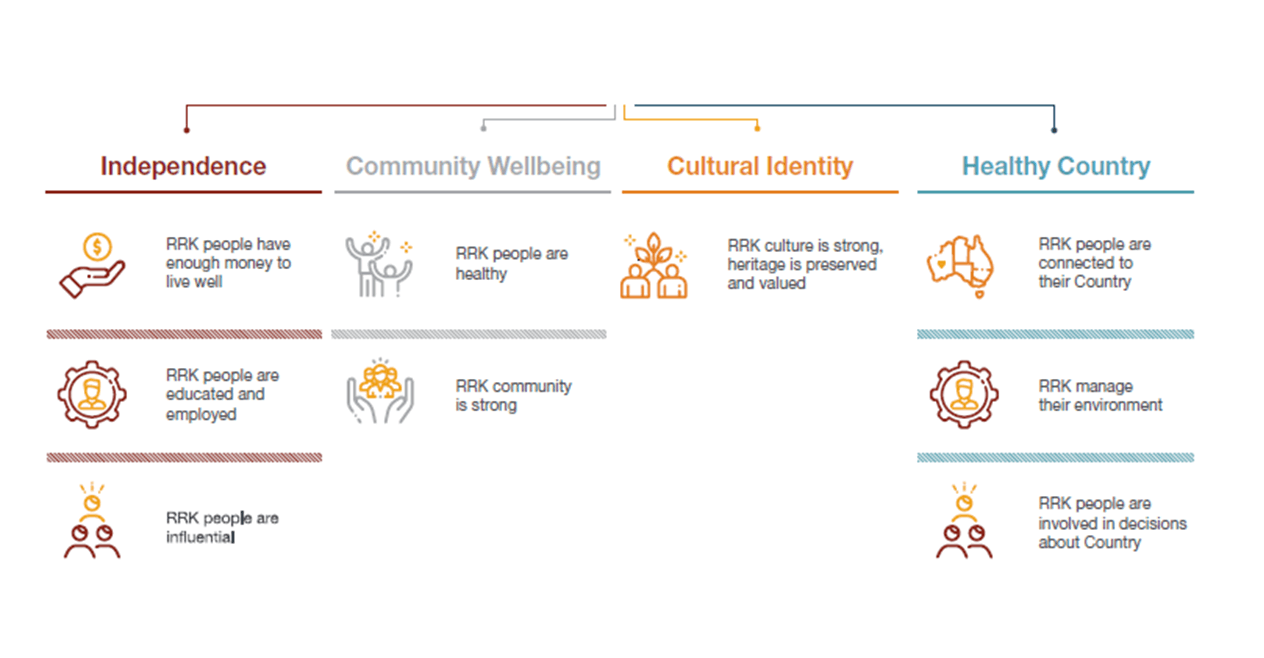
Working together as a community to establish a solid foundation towards independence,
community wellbeing, cultural identity, and healthy Country now and for future generations.
Working together as a community to establish a solid foundation towards independence,
community wellbeing, cultural identity, and healthy Country now and for future generations.
Independence – We are able to make our own choices as individuals, families and community
Community Wellbeing – Our people are well and our community is strong
Cultural Identity – We are connected to our Country and our culture lives on
Healthy Country – We are at the centre of caring for our Country and managing our land

“The Robe River Kuruma believe that a long time ago, this land was soft and malleable… It was at that time that the ancestral beings created the current physical features of the land…The ancestral beings put the Kuruma language and people in the land, and also laid down the laws to govern the Robe River Kuruma people and how they behave.”
“It is these laws and customs that connect the Robe River Kuruma people to their country.”
Justice Michael Barker, KM Part A Determination 1 Nov 2016

In 1999, the RRK people lodged their native title application in the Federal Court. The Robe River Kuruma determination is divided into Part A and Part B.
The Part A area was determined on the 1st November 2016, with an on-Country Federal Court hearing. The consent determination recognised the Robe River Kuruma people’s exclusive and non-exclusive rights to an area of about 4,123 square kilometres in size. The Part A area is often referred to as the Silvergrass area and is home to many sacred sites and permanent pools along the Jajiwurra (Robe) River.
The Part B area was determined on the 26th April 2018. The Part B determination area includes the Jajiwurra (Robe) River, the Bungaroo Valley and the Buckland Ranges, and covers an area of around 5, 720 square kilometres.

The RRK people have traditional rights to an area of about 15,759 square kilometres in Western Australia’s Pilbara region within the Shire of Ashburton and Pannawonica.
The Part B area is particularly significant as Jajiwurra has long been considered the lifeblood of the RRK People, and the ‘main artery of RRK country’. Jajiwurra is central to the RRK people’s identity, and it is where we take our name as the Robe River Kuruma People.
RRK People’s understanding of our identity and our place in the world, and that of the river, cannot be separated. Jajiwurra contains other significant places such as archaeological sites, many named pools, yintas, increase sites, law grounds, shelters, rockshelters, camping and occupation sites along the entire route of the river. Jajiwurra also holds significant environmental values, and is integral to sustaining life in the region.
The Bungaroo cultural precinct, often described as Bungaroo Creek or Bungaroo Valley, is a spiritually and culturally significant place for the Robe River Kuruma People – it has supported our way of life for generations. Bungaroo is considered to be a fundamental part of the Kuruma law cycle and it is an important travelling route between Jajiwurra and ceremonial places to the south. Bungaroo is considered a living place, with a powerful, creative life force that can be called upon to effect change within Country.
This is where our heart is, our soul, our spirit, our Dreaming. And our Old People [spirits] still walk this country today.
Leanne Evans
Bungaroo is situated at the western end of the Hamersley Range, and includes the Buckland Ranges, Bungaroo, Jimmawurrada and Piwangkurr creeks and the hills to the north of them. The town of Pannawonica is located 12 km southwest to the closest point of the area, and 53 km southeast to its furthest point.
There are currently several mining proponents interested in exploring and or mining in the area. This would involve mining sections of the Bungaroo Creek, and plans to extract water from the valley floor to be used in other mining projects. Other proponents are also undertaking exploratory works. The Water Corporation also has an existing water extraction program at Bungaroo (Bungaroo Coastal Water Supply). The water extracted is used as a water supply to nearby towns, and is also used and significantly managed by mining operations in the general vicinity.
For Robe River Kuruma People these represent significant threats to the cultural values that attribute to Bungaroo.





Please note: Aboriginal and Torres Strait Islander people should be aware that this website may contain images, voices or names of deceased persons in photographs, film, audio recordings or printed material.